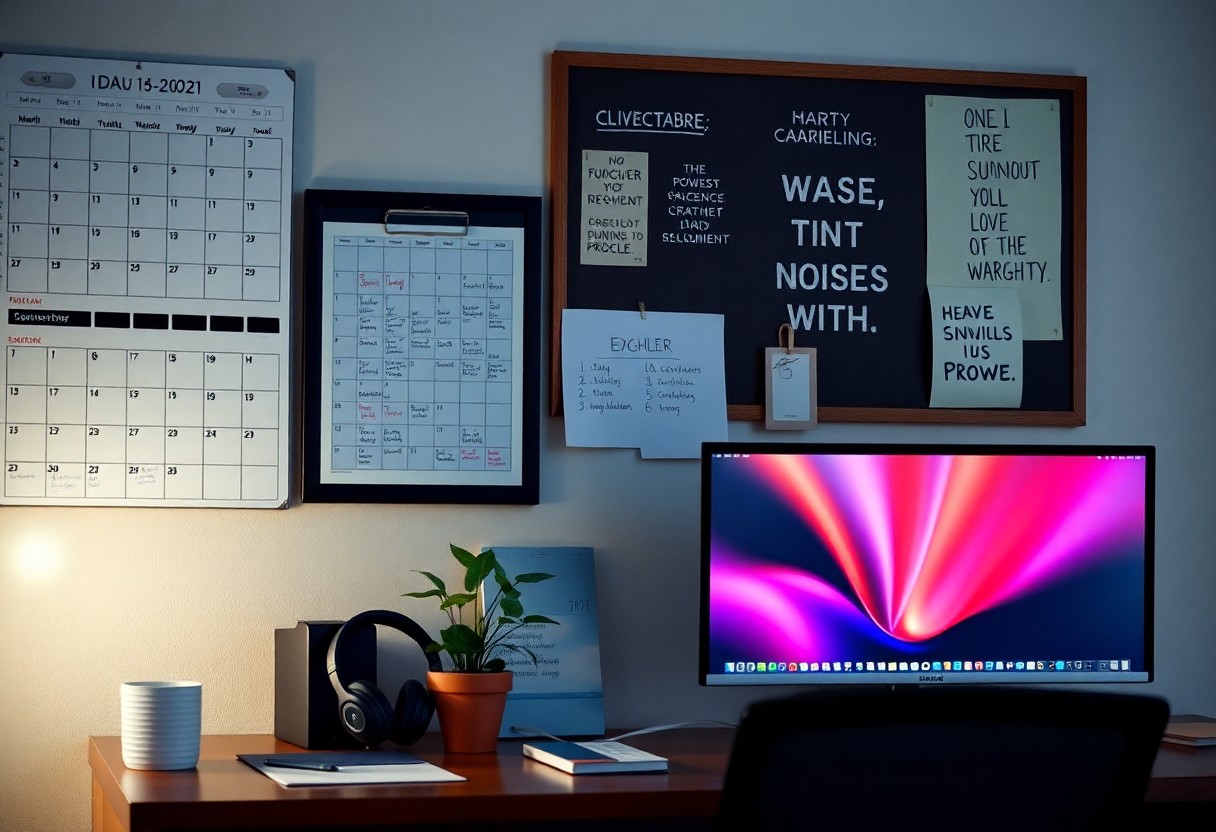There’s a pervasive issue affecting productivity in many workplaces: procrastination. In your professional life, overcoming procrastination is vital for maintaining progress and achieving your goals. By implementing effective strategies, you can boost your focus, increase your efficiency, and cultivate a more rewarding work experience. This post will explore practical techniques that you can use to train yourself to minimize distractions and enhance your productivity, enabling you to take charge of your tasks and time.

Key Takeaways:
- Set clear, achievable goals with specific deadlines.
- Break tasks into smaller, manageable steps to reduce overwhelm.
- Establish a consistent daily routine to foster productivity.
- Limit distractions by creating a focused work environment.
- Use time management techniques like the Pomodoro Technique.
- Prioritize tasks based on urgency and importance.
- Practice self-compassion and reflection to overcome setbacks.

Understanding Procrastination
Procrastination isn’t merely about putting off tasks; it’s a complex behavior influenced by various factors. Often, it stems from fear of failure, perfectionism, or lack of motivation. By recognizing these underlying causes, you can tailor your approach to tackle procrastination effectively. Understanding your habits and psychological responses can illuminate the path to productivity, transforming your work ethic.
Identifying Triggers
Your procrastination triggers can be both internal and external. Internal triggers include feelings of anxiety or self-doubt, while external ones might be distractions such as social media or a disorganized workspace. By pinpointing these triggers, you can strategize ways to mitigate their impact, fostering a more focused work environment.
The Psychology Behind Procrastination
Psychological factors play a significant role in procrastination. Fear of judgment or disappointing others often leads to delayed actions. Additionally, individuals with perfectionist tendencies may avoid tasks to prevent subpar results. Studies show that about 20% of adults admit to regularly procrastinating, indicating a widespread issue that affects productivity.
Setting Clear Goals
Establishing clear goals acts as a roadmap for your daily tasks and broader career journey. Defined objectives help you maintain focus, making it easier to prioritize and allocate your time efficiently. When your goals are specific, measurable, and time-bound, you reduce the likelihood of succumbing to distractions and procrastination. Clarity in your intentions propels you forward, transforming overwhelming tasks into structured, achievable steps.
Short-term vs. Long-term Goals
Understanding the distinction between short-term and long-term goals enhances your productivity. Short-term goals provide immediate benchmarks for progress, while long-term goals articulate your broader aspirations. Creating a balance between these two types ensures that your daily actions align with your ultimate objectives, fostering a sense of accomplishment and motivating you to stay on track.
SMART Criteria for Goal Setting
Applying the SMART criteria—Specific, Measurable, Achievable, Relevant, and Time-bound—enhances the effectiveness of your goals. Each component ensures that you not only define what you want to achieve but also outline how it can be accomplished. For instance, instead of saying, “I want to get better at my job,” a SMART goal would be, “I will complete three professional development courses by the end of the quarter.” This clarity and structure serve as powerful motivators.
The SMART framework assists in refining your objectives for maximum effectiveness. Specificity reduces ambiguity; measurement allows you to track progress; achievability ensures that your goals are realistic; relevance guarantees alignment with your career path; and time-bound elements instill urgency. For example, a goal such as “I will increase my sales by 20% in the next six months” encapsulates all five criteria. By consistently applying the SMART framework, you cultivate a disciplined approach to your professional growth that significantly curtails procrastination tendencies.
Time Management Techniques
Effective time management techniques can transform your productivity levels, helping to overcome procrastination. Methods such as the Pomodoro Technique and various prioritization strategies allow you to structure your workday efficiently, ensuring that you focus on high-impact tasks while minimizing distractions. By implementing these frameworks, you can create a well-balanced workflow that keeps you on track and boosts your overall performance.
The Pomodoro Technique
The Pomodoro Technique breaks your work into focused intervals, usually 25 minutes, followed by a short break. This method enhances concentration and prevents burnout by promoting regular pauses for rest and rejuvenation. You can use a timer to keep track of these intervals, ensuring you remain committed to your tasks while managing your energy levels effectively.
Prioritization Methods
Employing prioritization methods helps you identify and tackle the most important tasks first. Techniques such as the Eisenhower Matrix or ABC prioritization classify tasks based on urgency and impact, allowing you to allocate your time effectively. This structured approach ensures that you are not just busy but working on what truly matters for your success.
For instance, the Eisenhower Matrix divides tasks into four categories: urgent and important, important but not urgent, urgent but not important, and neither urgent nor important. This visual representation aids you in making informed decisions about where to focus your efforts. By categorizing tasks, you can delegate or eliminate less critical activities, freeing up time for what genuinely contributes to your goals. Adopting prioritization methods not only enhances your efficiency but also reduces the anxiety that often accompanies overwhelming workloads.
Building a Productive Environment
A productive environment significantly influences your ability to focus and complete tasks efficiently. By shaping your surroundings to eliminate interruptions and foster motivation, you can create a workspace that encourages sustained effort. Consider implementing elements like natural light, personal decorations, and organizational tools that resonate with your workflow. Such adjustments can greatly elevate your mental state, making it easier to manage your time and reduce procrastination.
Minimizing Distractions
Identifying and minimizing distractions is necessary for maintaining focus at work. Turn off unnecessary notifications on your devices, set specific times to check emails, and work in a quiet area if possible. Using techniques like the Pomodoro Technique can be beneficial, allowing you to dedicate focused bursts of time to tasks, followed by short breaks to refresh your mind.
Organizing Workspaces
An organized workspace enhances your ability to work efficiently and reduces the likelihood of procrastination. Keep only necessary items on your desk, and utilize storage solutions like bins or drawer organizers to contain paperwork and supplies. Digital organization matters too; implement file systems on your computer that mirror your physical workspace to create a seamless workflow.
When you organize your workspace, consider adopting a minimalist approach, which has been shown to improve focus by reducing clutter and improving information retention. Allocate designated areas for specific tasks, such as a corner for reading or a space solely for brainstorming ideas. Utilize labels and folders to systemize your documents systematically. By developing a personalized organization system that works for you, distractions are minimized, allowing for greater concentration on your tasks.

Developing Self-discipline
Self-discipline is the backbone of overcoming procrastination. Cultivating this trait requires consistent effort and a willingness to confront discomfort. By setting clear goals and adhering to them, you create a structure that helps you resist distractions. Incorporate small daily challenges that push your limits, gradually building your mental resilience. The more you practice self-discipline, the easier it becomes to tackle tasks head-on and maintain focus.
Habit Formation Strategies
To develop self-discipline, implement habit formation strategies that promote consistency and routine. Start small by choosing one habit to establish, such as setting specific work hours or creating a morning ritual. Use the 21/90 rule: practice your chosen habit for 21 days to form it, then continue for 90 days to make it a permanent part of your routine. Reinforcing your new behavior systematically makes it easier to maintain discipline.
Accountability Partners
An accountability partner can greatly enhance your discipline by providing support and motivation. Sharing your goals with someone else creates a mutual responsibility that keeps you focused. Regular check-ins with this partner can help to reinforce your commitments and provide constructive feedback when you’re slipping.
Choosing the right accountability partner is key to success. Look for someone who shares similar goals or aspirations, ensuring you both understand each other’s challenges. This relationship should involve setting measurable objectives and establishing a schedule for progress updates. As you report on your achievements and areas of difficulty, the shared responsibility increases your commitment. Most importantly, the feedback and encouragement you receive from your partner can help you remain motivated, ultimately leading to greater productivity and reduced procrastination.
Utilizing Technology
Technology offers a suite of tools that can enhance your productivity, streamline your tasks, and eliminate procrastination. By leveraging the right software and applications, you can create reminders, organize projects, and prioritize deadlines, turning your digital devices into powerful allies against distraction.
Productivity Apps
Productivity apps such as Todoist, Trello, and Notion help you organize your tasks and commitments efficiently. These applications provide user-friendly interfaces that allow you to set priorities, assign deadlines, and track progress seamlessly. With customizable features, they adapt to your workflow, making it easier to stay on task and mitigate procrastination.
Time Tracking Tools
Time tracking tools like Toggl and Clockify offer insights into how you spend your hours at work. By logging your activities, you can identify patterns of procrastination and allocate more time to important tasks. These tools help hold you accountable, ultimately fostering a sense of discipline in your work routine.
The implementation of time tracking tools reveals invaluable data about your work habits. You might discover, for example, that social media consumes more time than anticipated, leading to strategic adjustments in your day. Many users report a productivity boost of up to 25% after tracking their time for just one week, as it encourages you to focus on high-priority tasks and enhances your overall efficiency.
Summing up
Upon reflecting, you can train yourself to stop procrastinating at work by implementing structured time management techniques, setting specific goals, and breaking tasks into manageable steps. Prioritize your responsibilities and use tools like to-do lists or digital planners to keep track of your progress. Establish a productive workspace and eliminate distractions to maintain focus. Additionally, develop self-discipline by setting deadlines for tasks, rewarding yourself for progress made, and seeking accountability from colleagues. Consistent practice of these strategies will gradually enhance your productivity and reduce procrastination.
FAQ
Q: What techniques can professionals use to manage their time effectively to combat procrastination?
A: Techniques such as the Pomodoro Technique, time blocking, and the two-minute rule can help professionals structure their work time efficiently, allowing for focused bursts of productivity followed by short breaks.
Q: How can setting specific goals help in overcoming procrastination?
A: Setting specific, measurable, achievable, relevant, and time-bound (SMART) goals provides clarity and direction, making it easier for professionals to stay on track and take action.
Q: What role does the work environment play in reducing procrastination?
A: A clutter-free and organized work environment minimizes distractions, promotes focus, and encourages professionals to engage with their tasks rather than postpone them.
Q: How can accountability partners assist in reducing procrastination?
A: Having an accountability partner can create a support system where both individuals encourage each other to stay on task, thus fostering commitment and motivation to complete their work.
Q: In what ways can self-reflection help professionals stop procrastinating?
A: Self-reflection allows professionals to identify triggers for their procrastination, evaluate their productivity patterns, and adjust their approaches to improve overall performance.
Q: Why is it important to break tasks into smaller steps?
A: Breaking tasks into smaller, manageable steps makes them less overwhelming and easier to start, reducing the likelihood of procrastination.
Q: How can professionals effectively prioritize their tasks to diminish procrastination?
A: Utilizing prioritization methods such as the Eisenhower Matrix helps professionals distinguish between urgent and important tasks, enabling them to focus on what truly matters and minimize delays.
